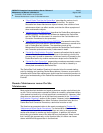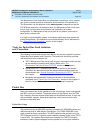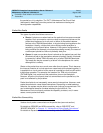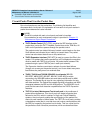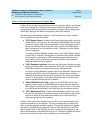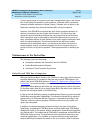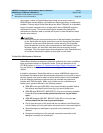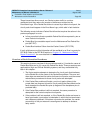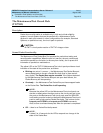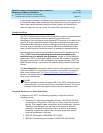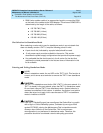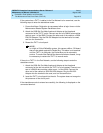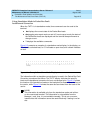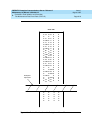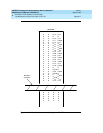
DEFINITY Enterprise Communications Server Release 6
Maintenance for R6vs/si
555-230-127
Issue 1
August 1997
Packet Bus Fault Isolation and Correction
Page 9-10The Maintenance/Test Circuit Pack (TN771D)
9
The Maintenance/Test Circuit Pack
(TN771D)
Description
Packet bus reconfiguration is available only in high and critical reliability
systems. In such systems that use the packet bus, a Maintenance/Test is
required in each port network. In other configurations (for example, Standard
Systems, no packet bus use), the circuit pack is optional.
!
CAUTION:
All TN771 circuit packs must be of TN771D vintage or later.
Normal Packet Functionality
The Maintenance/Test Packet Bus Port provides the packet bus testing and
reconfiguration capabilities. When the port is in service, the port continuously
monitors the packet bus for faults (or recovery from faults), and it reports this
information to packet bus maintenance.
The yellow LED on the TN771D Maintenance/Test circuit pack provides a visual
indication of the state of the packet bus, as follows:
■ Blinking at a rate of 1 per sec — the Maintenance/Test Packet Bus port
cannot swap leads to correct a Packet Bus fault (that is, there are too
many faults). The Packet Bus may be unusable. If the failures detected
by the Maintenance/Test Packet Bus port are open lead failures, the
Packet Bus may still be operating.
■ On steady — the Maintenance/Test Packet Bus port has swapped leads
on the Packet Bus. The Packet Bus is still operating.
NOTE:
Because the yellow LED on the Maintenance/Test circuit pack can
also be on steady when the other ports on the circuit pack are in use,
the ports on the Maintenance/Test circuit pack used for ISDN-PRI
trunk testing must be busied out before the Maintenance/Test circuit
pack is used to help resolve Packet Bus faults. This is done via the
busyout port PCSS02 and busyout port PCSS03 commands.
Also, be sure to release these ports when the process is completed.
■ Off — there is no Packet Bus fault present.
NOTE:
It takes 5 to 10 seconds for the LED to respond to a change in the
state of the Packet Bus.



